Periodontal disease (PD), which includes plaque-induced gingivitis and periodontitis, is a chronic inflammatory condition affecting the supporting tissues of the teeth. Untreated plaque-induced gingivitis may develop to periodontitis, resulting in tooth mobility and, eventual, the loss of teeth (1, 2). According to reports, the combined prevalence of periodontal disease in adults is 61.6%, with severe periodontitis affecting ~23.6% (3). This not only imposes a significant economic burden but also severely impacts patients' nutrition status and quality of life (4, 5). Moreover, the role of periodontitis in promoting systemic inflammation and leading to dysfunction in specific organs has been widely documented, including associations with cardiovascular diseases, metabolic disorders, neurodegenerative diseases, autoimmune conditions, cancer, and adverse pregnancy outcomes (6–12).
Adverse pregnancy outcomes (APOs) refer to a range of medical events that may negatively impact the health of both mothers and infants during pregnancy, childbirth, or the postpartum period. These include five primary APOs identified from medical birth registries: preterm birth (PB), small for gestational age (SGA), pre-eclampsia (PE), other hypertensive disorders, and gestational diabetes mellitus (GDM), along with other pregnancy-related complications such as miscarriage, stillbirth, placental problems, congenital abnormalities, and postpartum complications (13). According to previous research data, ~30% of women experience at least one unfavorable pregnancy result during their reproductive years (14). The occurrence of APOs is not only a significant contributor to rising rates of morbidity and mortality for mothers and newborns but also crucially elevates the risk of various long-term complications for both, including neurodevelopmental abnormalities, cardiovascular diseases, and other chronic conditions (15).
Since Offenbacher et al. (16) first reported in 1996 that women with periodontitis have nearly seven times the risk of PB and low birth weight (LBW) compared to controls, numerous studies have confirmed the negative consequences of PD on APOs from various perspectives, including epidemiology, shared pathophysiological mechanisms, histological studies, animal experiments, and intervention research. Epidemiological research suggests that the prevalence of PD in pregnant women varies between 20 and 50% (17). Furthermore, multiple studies assessing the correlation between periodontitis and APOs (such as PB, LBW, and PE) have consistently found a positive correlation between the two (18, 19). In 2020, Bobetsis et al. (20) refined the model of the pathogenic mechanisms by which periodontitis affects APOs, along with other relevant research data (21), indicating that periodontitis promotes APOs primarily through three pathways: the uterine oral colonization of periodontal germs, the imbalance of intrauterine inflammatory responses triggered by pro-inflammatory mediators, and the ascent of urogenital pathogens leading to intrauterine infection. Additionally, periodontal pathogens have been found in embryonic tissues by histological investigations, such as the placenta, fetus, and umbilical cord blood, providing strong evidence for the presence of oral infections in the fetal-placental structure (21). Moreover, numerous animal experiments have demonstrated that pregnant mouse models infected with various periodontal pathogens exhibit symptoms such as fetal growth restriction (FGR) and PB, significantly increasing the incidence of LBW in offspring (22–24). These findings collectively suggest a correlation between periodontitis and APOs. However, the effectiveness of clinical interventions for periodontitis in preventing and treating APOs remains unclear. Most studies indicate that periodontal interventions primarily improve periodontal parameters without significantly impacting the occurrence of APOs (25–29). Nonetheless, it is widely recognized that periodontitis is an independent and potential risk factor for APOs.
The aforementioned studies primarily focus on the elevated risk of APOs associated with PD; however, the connection between pregnancy and changes in oral health is bidirectional. Physiological changes during pregnancy significantly affect the immune, respiratory, cardiovascular, and coagulation systems (30). To accommodate the semi-allogeneic fetus, the immune system is suppressed during pregnancy (31). Research indicates that pregnancy impairs neutrophil function, increasing susceptibility to inflammation, which in turn reduces the gingival tissue's ability to resist bacterial-induced inflammatory challenges (32). Additionally, pregnancy induces significant hormonal changes, particularly in sex hormones. Receptors for these hormones are widely expressed in gingival tissues and cells, exacerbating the inflammatory response to plaque-induced periodontal tissue damage (33, 34). Studies have shown that estrogen and progesterone can regulate the microbial composition within periodontal tissues, raising the anaerobic to aerobic bacterial ratio during pregnant. Although a recent cohort analysis revealed no appreciable variations in the percentage of subgingival periodontal pathogens throughout pregnancy, with marked differences observed post-delivery, this still supports the hypothesis that gingival inflammation severity fluctuates during and after pregnancy (17, 35). Moreover, pregnancy hormones may compromise the integrity of periodontal ligament cells, worsening clinical PD symptoms (36). Changes in dietary habits during pregnancy, such as increased refined sugar and protein intake, also promote the growth of plaque-related pathogenic microorganisms (32). These findings suggest that pregnancy-associated physiological traits, hormonal fluctuations, dietary modifications, and reduced oral hygiene interventions contribute to a shift in oral microbial balance, thereby increasing susceptibility to oral diseases.
The complex and bidirectional relationship between pregnancy and PD has emerged as a prominent interdisciplinary topic of interest. However, as knowledge in this area rapidly accumulates, it becomes increasingly challenging to thoroughly understand the knowledge framework and stay updated on the latest research trends, especially for researchers new to the field. Numerous systematic reviews have carried out quantitative assessments on APOs and PD in recent years, concentrating on certain subfields such PD as an APOs risk factor (37), the association between PD and various APOs (38–40), and the effects of non-surgical periodontal treatments on APOs (41). Nevertheless, a comprehensive, macro-level analysis of the knowledge landscape and thematic evolution in this domain remains lacking.
Bibliometrics, first defined by Alan Pritchard in 1969, is a method of quantitative analysis that examines relevant literature, coverage areas, and citation patterns to reveal and evaluate development trends, author collaboration networks, and the transfer of knowledge within a particular research domain (42, 43). It has been used extensively in medical research over the past few decades, including studies on PD (44), obstetric and gynecological disorders (45), cardiovascular diseases (46), and metabolic diseases (47). In recent years, the quantity of articles about PD and APOs has grown rapidly, yet systematic analyses using bibliometric methods remain scarce. Therefore, this study attempts to outline the general framework of research on the association between PD and APOs by summarizing and analyzing the quantitative data and research structure currently available in this subject using a bibliometric approach. The findings highlight the research priorities and emerging trends, providing scientific evidence for future research directions and academic decision-making.
2 Methods 2.1 Data source and search strategyThe Web of Science Core Collection (WOSCC) database (https://www.webofscience.com) served as the data source for this investigation, which widely regarded as the premier database for bibliometric analysis (48). The search query employed was “TS = (“periodontal disease” OR periodont* OR gingiv* OR “tooth loss” OR “tooth migration” OR “tooth mobility”) AND TS = (“Adverse pregnancy outcomes” OR “Miscarriage” OR “Preterm birth” OR “Low birth weight” OR “Congenital anomalies” OR “Stillbirth” OR “Maternal complications” OR “Placental issues” OR “Postpartum complications”).” All retrieved documents were independently evaluated by two reviewers (MMZ and HXC) based on titles, abstracts, and keywords to exclude studies unrelated to PD and APOs. In cases of disagreement between the two reviewers, the judgment of a third reviewer (YXY) was deemed final. To minimize bias from database updates, the literature search was completed in a single day (2024-09-22).
2.2 Inclusion criteriaPublications that meet all of the following criteria are included in the subsequent analysis, while others are excluded:
(1) Articles or review papers related to the field of PD and APOs;
(2) Articles or review papers published between 2000 and 2023;
(3) Articles or review papers written in English.
2.3 Exclusion criteriaPublications meeting any of the following criteria are excluded from this study:
(1) Publications before 2000 or after 2023;
(2) Publication types other than articles, review papers, and early access;
(3) Non-English publications.
2.4 Data collection and data analysisThe collected papers were exported as “Full Record and Cited References” and saved in “Plain Text” format, with the files named “download_.txt.” We utilized Microsoft Office Excel 2019 to manage data and analyze annual publications. Furthermore, CiteSpace [6.3.R1 (64-bit) Advanced] was employed to analyze the data and create visual representations of scientific knowledge maps.
The Java-based citation visualization program CiteSpace, created by Chaomei Chen's group, gives researchers an experimental platform to investigate new concepts and assess current methodologies. It allows for in-depth analysis of literature from various perspectives, identifying research trends and hotspots in particular domains, and presenting them visually. The generated knowledge maps offer researchers an intuitive approach to comprehending the development of research focuses, enabling them to predict future trends in areas of interest (49).
3 Results 3.1 General informationIn total, 1,118 publications were obtained as a result of the literature search. After screening, 932 publications were included in the subsequent bibliometric analysis, comprising 728 research articles (728/932, 78.112%) and 208 review articles (208/932, 22.318%). Of the four early access articles, three were categorized as research articles, and one as a review article (Figure 1; Supplementary Table 1). From 2000 to 2003, the annual quantity of publications in this area remained below ten. However, since 2004, the annual publication count has significantly increased (R2 = 0.674), peaking at 75 publications in 2023 (Figure 2; Supplementary Table 2). As illustrated in Figure 2, the number of publications steadily grew between 2004 and 2011, reaching 58 publications in 2011. This growth indicates the increasing academic attention toward this research area. During the period from 2012 to 2018, publication volume fluctuated but remained at a relatively high level (averaging more than 40 publications per year). Between 2019 and 2023, the publication volume experienced explosive growth, culminating in the peak of 75 publications in 2023. Since 2019, the number of publications has remained consistently high, reflecting active research activities and significant interest from the academic community. This trend indicates that academic interest in the relationship between PD and APOs has steadily increased since 2004, with research activities remaining robust from 2007 to 2023, highlighting sustained attention from the international academic community.
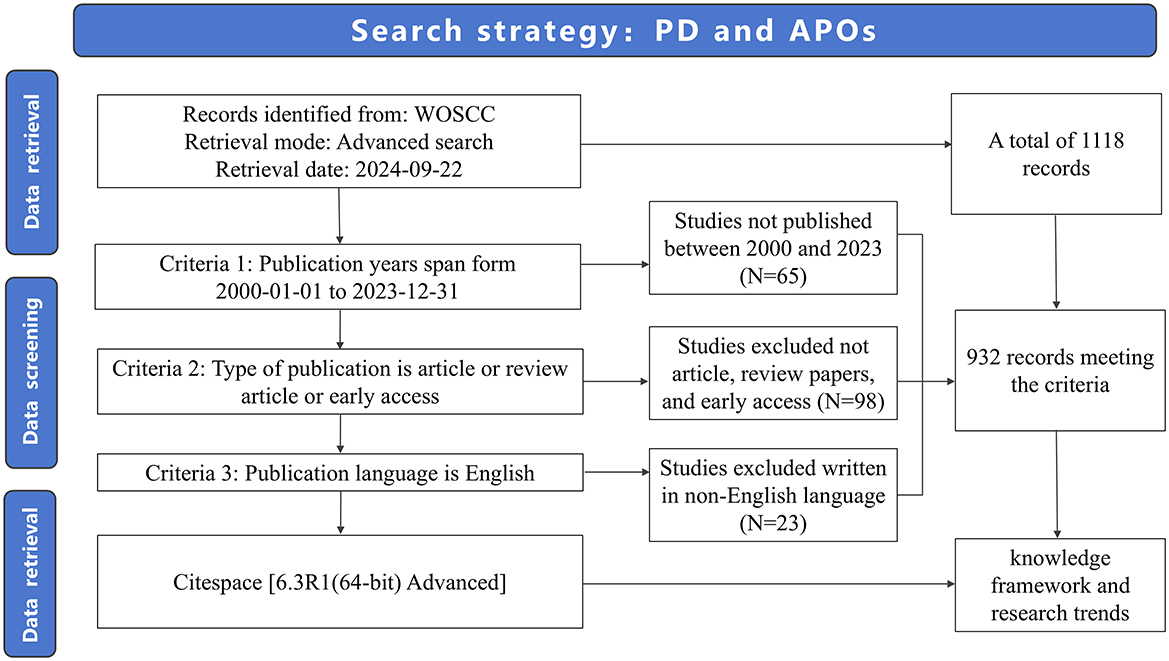
Figure 1. Flowchart of the search strategy.
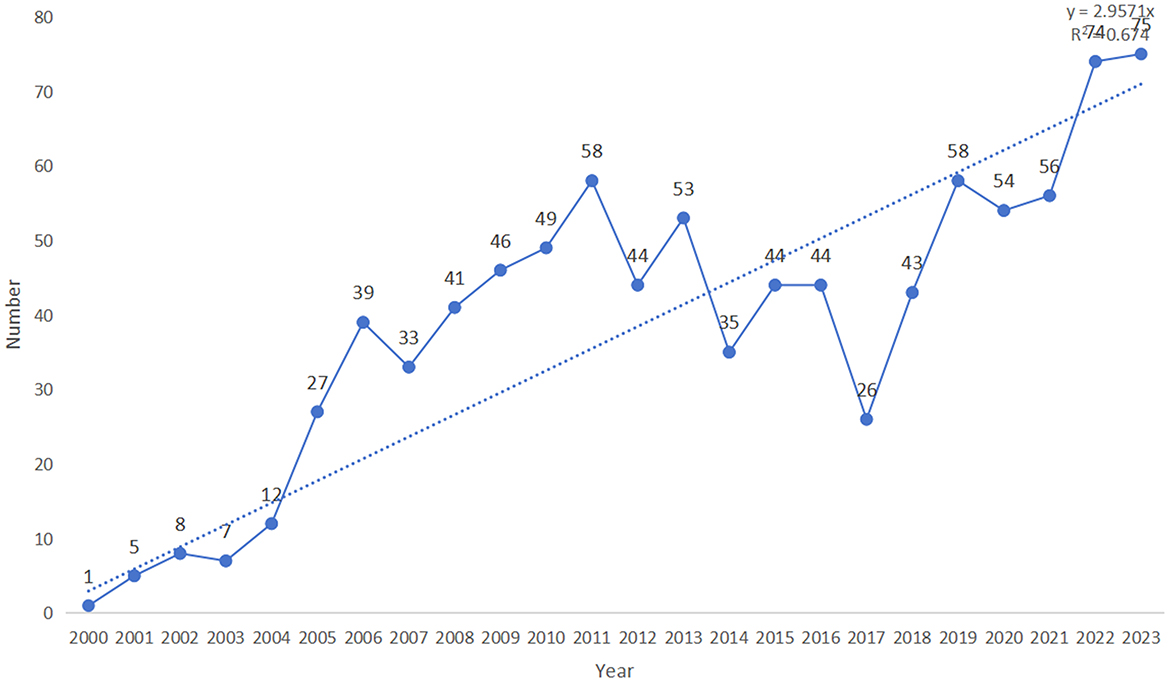
Figure 2. The number of published studies over time.
Overall, since 2000, this research field has undergone several phases of growth, particularly with the rapid expansion observed after 2019. This trend reflects the increasing attention within the academic community, suggesting that more research outcomes are likely to be published in the future, driving further advancements in this field.
3.2 Cooperation network analysis 3.2.1 Distribution of countries/regionsA total of 932 publications originated from 73 countries, with the United States contributing over one-third of the literature (355/932, 38.09%), followed by Brazil (85 publications) and India (59 publications; see Supplementary Table 3). This highlights the significant influence of the U.S. in this field. Furthermore, the U.S. exhibited the highest betweenness centrality (BC = 0.77), indicating a high level of collaboration with other countries, followed by Australia (0.14) and Canada (0.13; see Supplementary Table 3). The visualization of country/region collaborations reveals that the U.S.'s closest collaborators are primarily developed nations, including Australia, Canada, France, Germany, Italy, and Sweden (Figure 3).
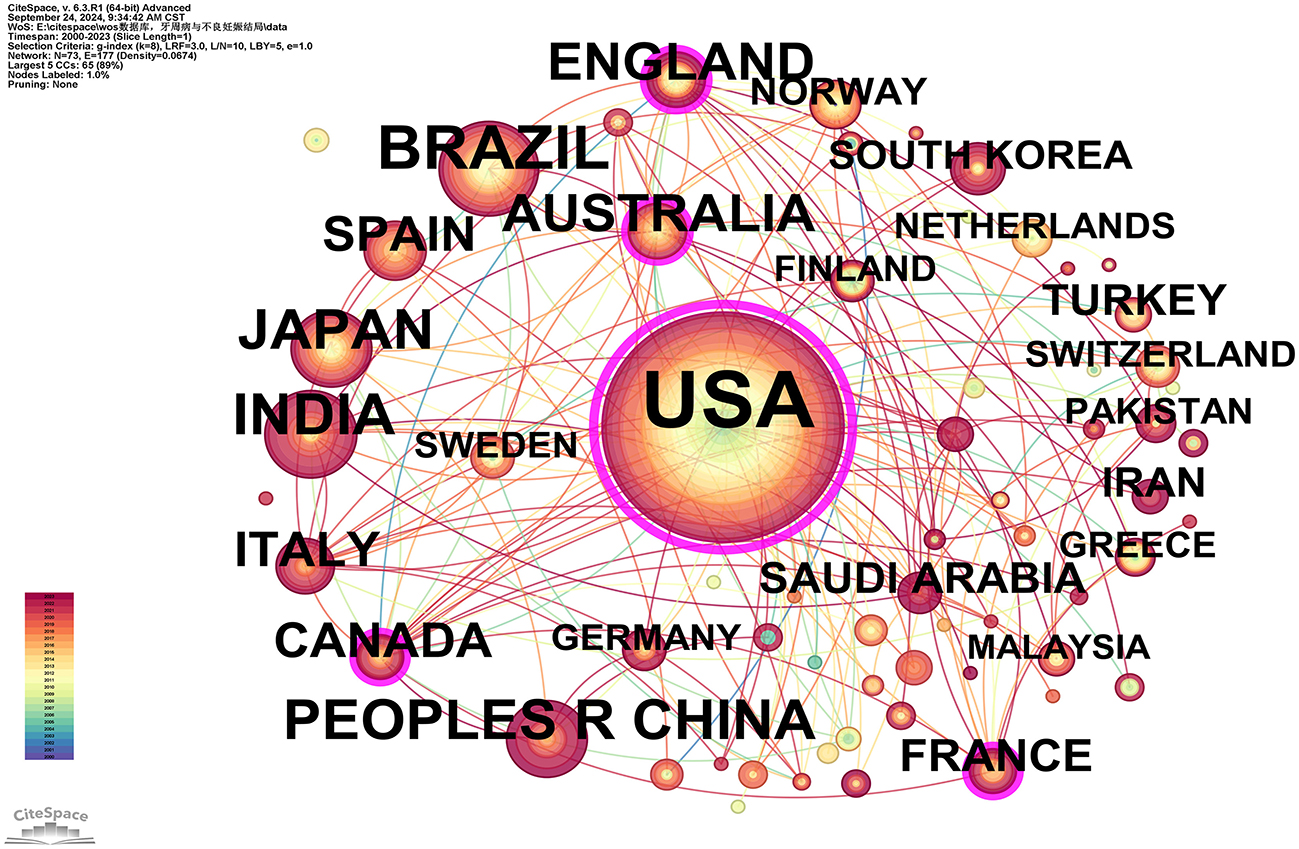
Figure 3. Cooperation network map of countries/regions. After standardizing the sample literature (932 publications), the data were imported into the software CiteSpace for analysis of the selected database, with the time period set from 2000 to 2023. The analysis item was set to “Country,” and a co-occurrence map of countries corresponding to studies on the relationship between PD and APOs was generated. The size of the nodes represents the number of publications, and the connections between nodes represent collaborations. The different colors represent the years of collaboration. The outermost purple rings indicate the levels of betweenness centrality (BC), with nodes of high BC considered as key points in the research field [g-index (k = 8), N = 73 (number of network nodes), E = 117 (number of connections), Density = 0.0674 (network density)].
3.2.2 Distribution of institutionsResearchers from 121 different institutions have made contributions to the study of this field. The top three institutions by number of publications are the University of North Carolina, the University of North Carolina at Chapel Hill, and Columbia University, with 34, 33, and 28 publications, respectively. Two institutions have a betweenness centrality (BC) >0.1: Columbia University (0.16) and the National Institutes of Health (NIH)—USA (0.11; see Supplementary Table 4). Figure 4 reveals the following characteristics of international research institutions and their collaborations in the study of the relationship between PD and APOs:
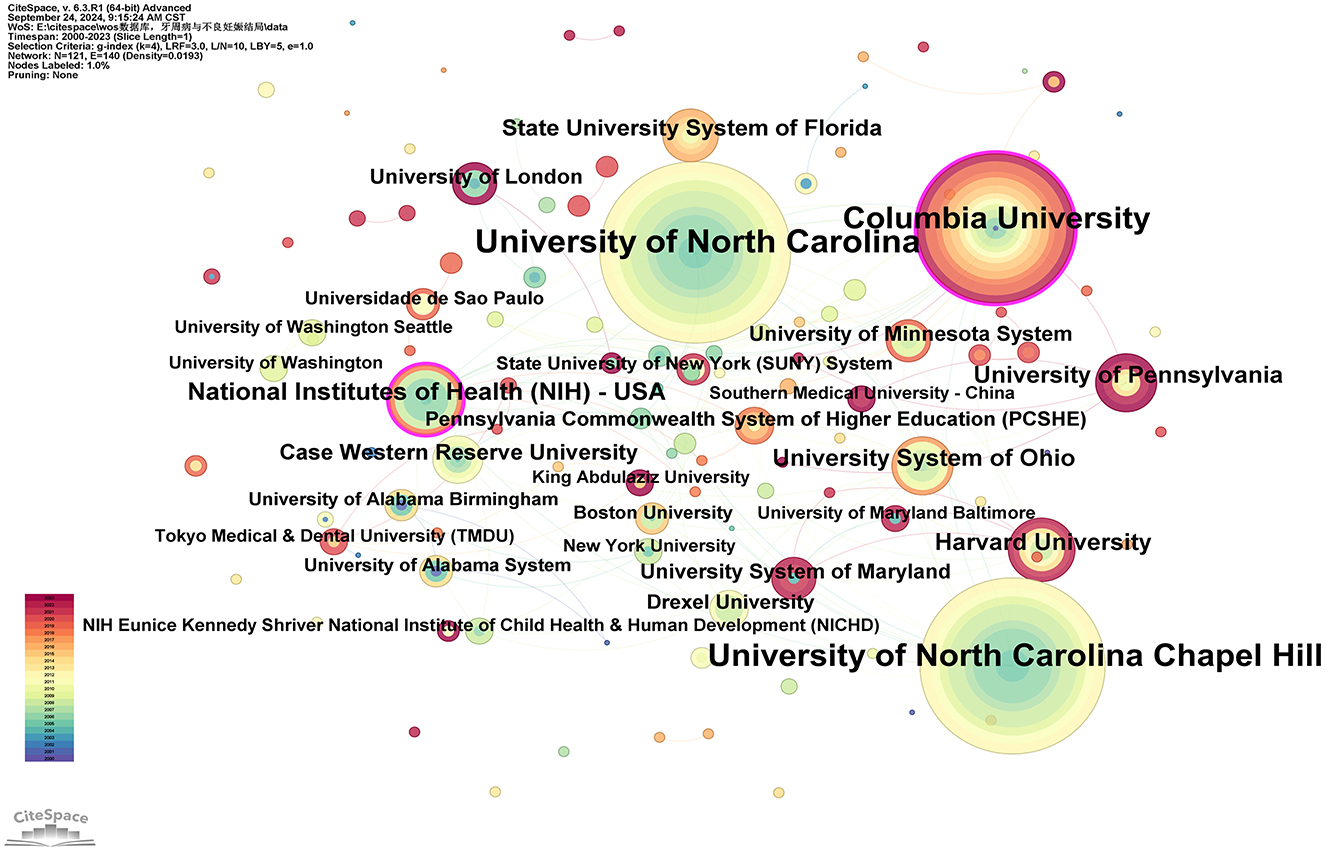
Figure 4. Cooperation network map of institutions. After normalizing the sample literature (932 publications), the data was imported into CiteSpace for analysis. The selected time period spanned from 2000 to 2023, with the analysis focused on the “institution” level to construct a co-occurrence network map of institutions researching the relationship between PD and APOs. Node size represents the number of publications, while the links between nodes indicate collaborative efforts. Different colors represent the years of cooperation. The outermost purple ring denotes the level of centrality, with high centrality nodes considered key points in the research field. The network parameters are as follows: g-index (k = 4), N = 121 (number of network nodes), E = 140 (number of connections), and Density = 0.0193 (network density).
(I) Key institutions: in terms of publication volume, several institutions have emerged as key players in research on the relationship between PD and APOs. The largest node, representing the institution with the highest number of publications, is the University of North Carolina, followed by the University of North Carolina at Chapel Hill, Columbia University, the National Institutes of Health (NIH)—USA, Harvard University, the University of Pennsylvania, the University System of Ohio, the State University System of Florida, Case Western Reserve University, and the University of London. These institutions form the core of research on the PD-APOs relationship.
(II) Research Trends and Geographic Distribution: In terms of publication volume, 17 out of the top 20 institutions are located in the United States, highlighting the significant influence of American institutions in this field. This aligns with the findings in Figure 3. The geographic distribution of research institutions is relatively widespread, with high levels of interest in this research area observed globally. Notably, research activity is particularly prominent in North Carolina, New York, Massachusetts, Ohio, Maryland, and Pennsylvania. Additionally, countries such as Brazil, India, Japan, China, Australia, and the United Kingdom also show high levels of research activity. This global distribution underscores the importance of PD-APOs relationship research and its broad international attention.
3.2.3 Authors and co-cited authorsIn total, 94 authors have been involved in contributing to the research publications on the relationship between PD and APOs. Only five authors have published more than five articles: Steven Offenbacher (24 articles), Boggess, KA (11 articles), Beck, JD (9 articles), Papapanou, Panos N (6 articles), and Ahn, Ki Hoon (5 articles; see Supplementary Table 5). As shown in Figure 5, the number of connections is fewer than the number of nodes, indicating a low network density, which suggests limited collaboration among key researchers in this field. Most researchers work independently with minimal co-authorship. Notably, some influential authors, especially Steven Offenbacher, Boggess, KA, and Beck, JD, have formed a significant research network in this field. Steven Offenbacher, in particular, has been an active contributor since publishing his first paper in 2001 and continued through 2023. Additionally, new authors contribute their first papers annually, indicating sustained interest and vitality in this research area (see Supplementary Table 5).
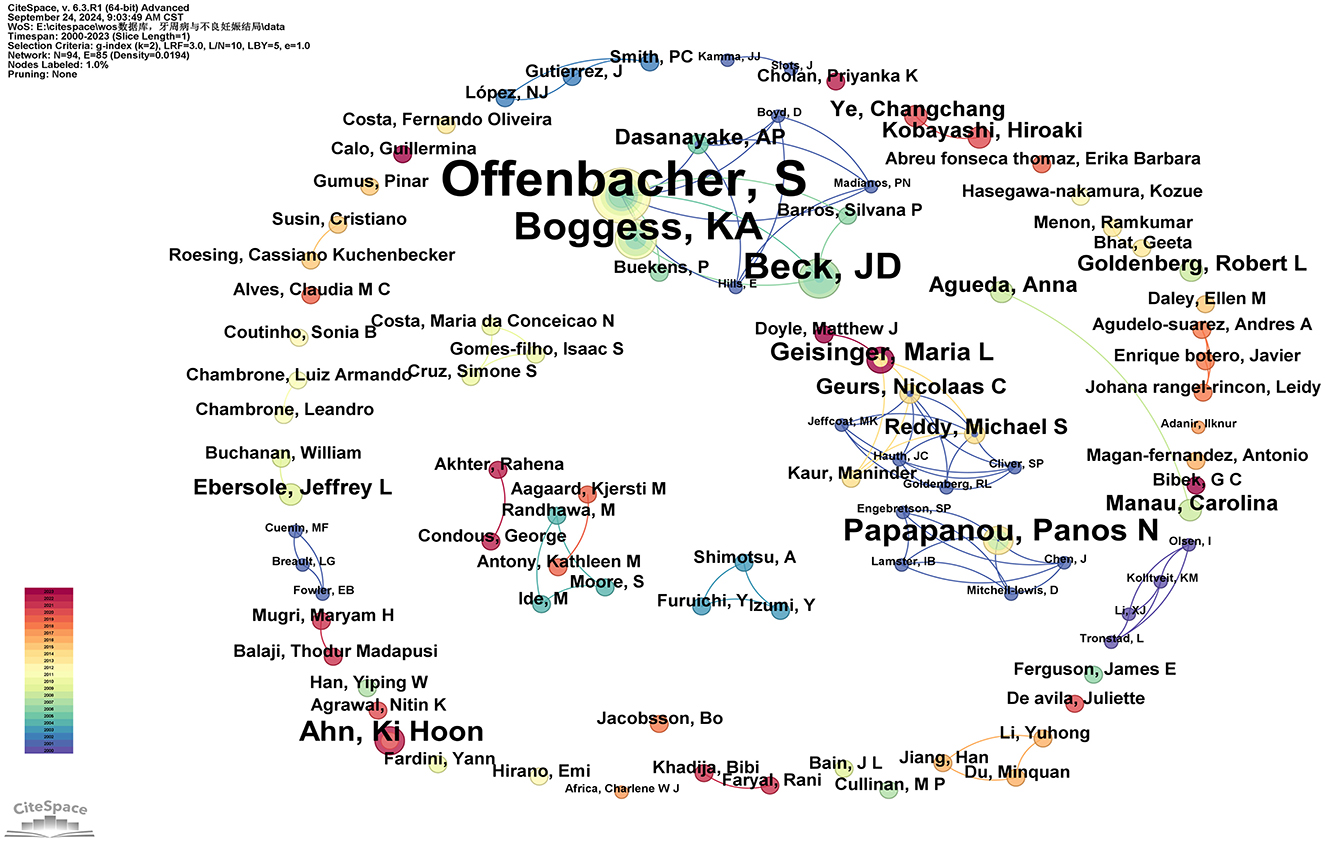
Figure 5. Cooperation network map of authors. After normalizing the sample literature (932 publications), the data was imported into CiteSpace for analysis. The selected time period spanned from 2000 to 2023, with the analysis focused on the “author” level to construct a co-occurrence network map of authors researching the relationship between PD and APOs. Node size represents the number of publications by each author, while the links between nodes indicate collaborative efforts. Different colors represent the years of cooperation. The network parameters are as follows: g-index (k = 2), N = 94 (number of network nodes), E = 85 (number of connections), and Density = 0.0194 (network density).
Co-citation refers to the situation where two or more authors are cited together in the same publication or across multiple publications. In our studies, all of the top ten co-cited authors have been cited over 100 times. The most frequently cited co-cited author is Steven Offenbacher (575 citations), followed by LÓPEZ NJ (345 citations), JEFFCOAT MK (310 citations), MICHALOWICZ BS (270 citations), and BOGGESS KA (224 citations). Additionally, eight authors have a centrality value exceeding 0.10 (see Supplementary Table 6), with Steven Offenbacher having the highest betweenness centrality (BC) value of 0.74, followed by ALDRIDGE JP (0.60), ASIKAINEN S (0.60), BALTCH AL (0.60), LÓPEZ NJ (0.47), JEFFCOAT MK (0.29), MICHALOWICZ BS (0.16), and DASANAYAKE AP (0.10). As illustrated in Figure 6, purple circles represent these highly central co-cited writers, highlighting their significant bridging role within the research network.
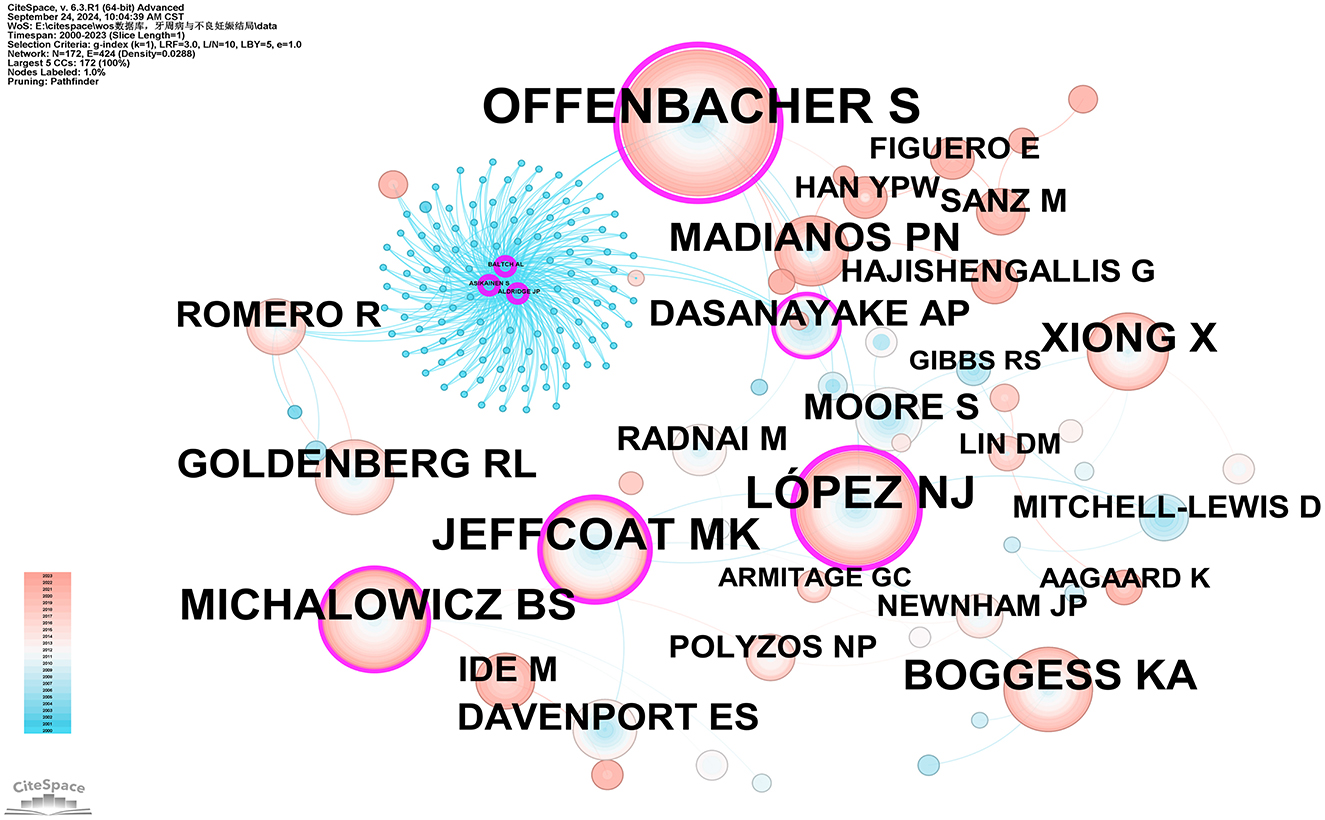
Figure 6. Co-citation network map of authors. After normalizing the sample literature (932 publications), the data was imported into CiteSpace for analysis. The selected time period spanned from 2000 to 2023, and the analysis focused on the “Author Co-citation Network” to construct a co-citation network map of authors researching the relationship between PD and APOs. Node size represents the number of citations each author received, while the links between nodes indicate co-citations within the same paper. Different colors represent the years in which the citations occurred. The network parameters are as follows: g-index (k = 1), N = 172 (number of network nodes), E = 424 (number of connections), and Density = 0.0288 (network density).
3.3 Co-cited document and journalsCo-citation analysis identifies core literature and research hotspots within a specific field by recognizing frequently co-cited publications. Using CiteSpace software with the g-index set to 2, a total of 186 co-cited publications were filtered. The three most cited publications are: Michalowicz BS, 2006, The New England Journal of Medicine (96 citations); Jeffcoat MK, 2003, Journal of Periodontology (64 citations); and Xiong X, 2006, BJOG: An International Journal of Obstetrics and Gynecology (63 citations). Additionally, three articles have a betweenness centrality (BC) of 1.00 or higher: Newnham JP, 2009, Obstetrics and Gynecology (BC = 1.09); Tarannum F, 2007, Journal of Periodontology (BC = 1.01); and Offenbacher S, 2009, Obstetrics and Gynecology (BC = 1; see Supplementary Table 7). Michalowicz BS, 2006, The New England Journal of Medicine (96 citations) and Newnham JP, 2009, Obstetrics and Gynecology (BC = 1.09) represent the most cited and the highest centrality articles, respectively, indicating their broad recognition and influence among scholars in the field (Figure 7).
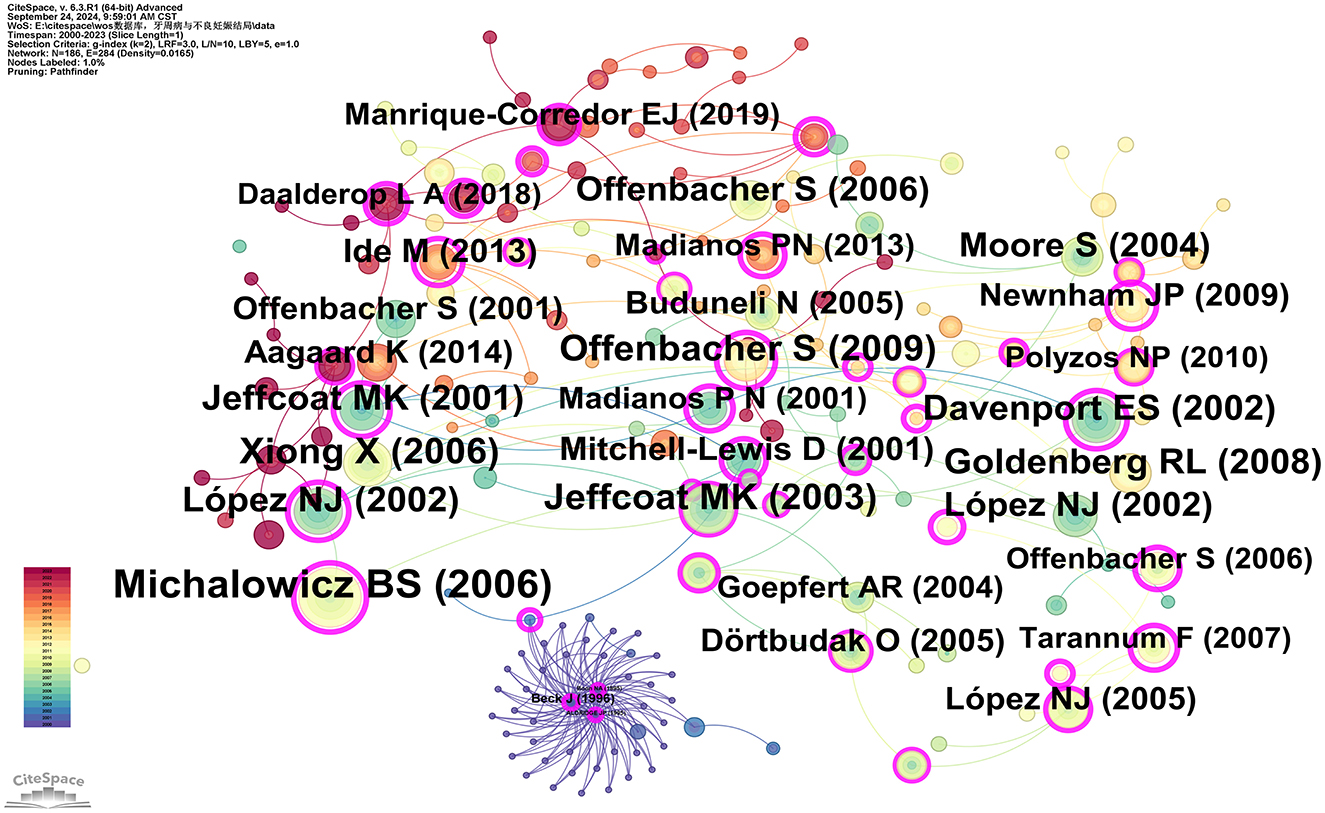
Figure 7. Co-cited network map of documents. After normalizing the sample literature (932 publications), the data were imported into CiteSpace for analysis. The selected time period spanned from 2000 to 2023, with the analysis focusing on “documents” to construct a co-citation network map of literature related to the relationship between PD and APOs. Node size represents the number of citations each document received, while links between nodes indicate that the documents were co-cited in the same paper. The different colors indicate the years in which citations occurred. The outermost purple ring signifies the degree of centrality, with nodes of high centrality regarded as key elements in the research field. The network parameters are as follows: g-index (k = 2), N = 186 (number of network nodes), E = 284 (number of connections), and Density = 0.0165 (network density).
Co-citation journal analysis identifies core journals and academic communication channels within a specific research area by analyzing the frequency of co-citation among journals. Using CiteSpace software with the g-index set to 3, a total of 180 journals were identified. As illustrated in Figure 8, the most cited journal and the journal with the highest betweenness centrality (BC) are the Journal of Periodontology (792 citations) and Acta Odontologica Scandinavica (BC = 0.55), respectively. Based on their citation frequency and related research areas, these journals are classified as core journals in periodontal research and obstetrics and gynecology research. The top five core journals in periodontal research based on citation frequency are: Journal of Periodontology (792 citations), Journal of Clinical Periodontology (683 citations), Journal of Dental Research (592 citations), Annals of Periodontology (507 citations), and Periodontology 2000 (414 citations). The top five core journals in obstetrics and gynecology research based on citation frequency are: American Journal of Obstetrics and Gynecology (544 citations), Obstetrics and Gynecology (494 citations), BJOG: An International Journal of Obstetrics & Gynecology (352 citations), Archives of Gynecology and Obstetrics (138 citations), and Acta Obstetricia et Gynecologica Scandinavica (131 citations). The high citation rates of these journals indicate their significant influence within their respective fields (see Supplementary Table 8).
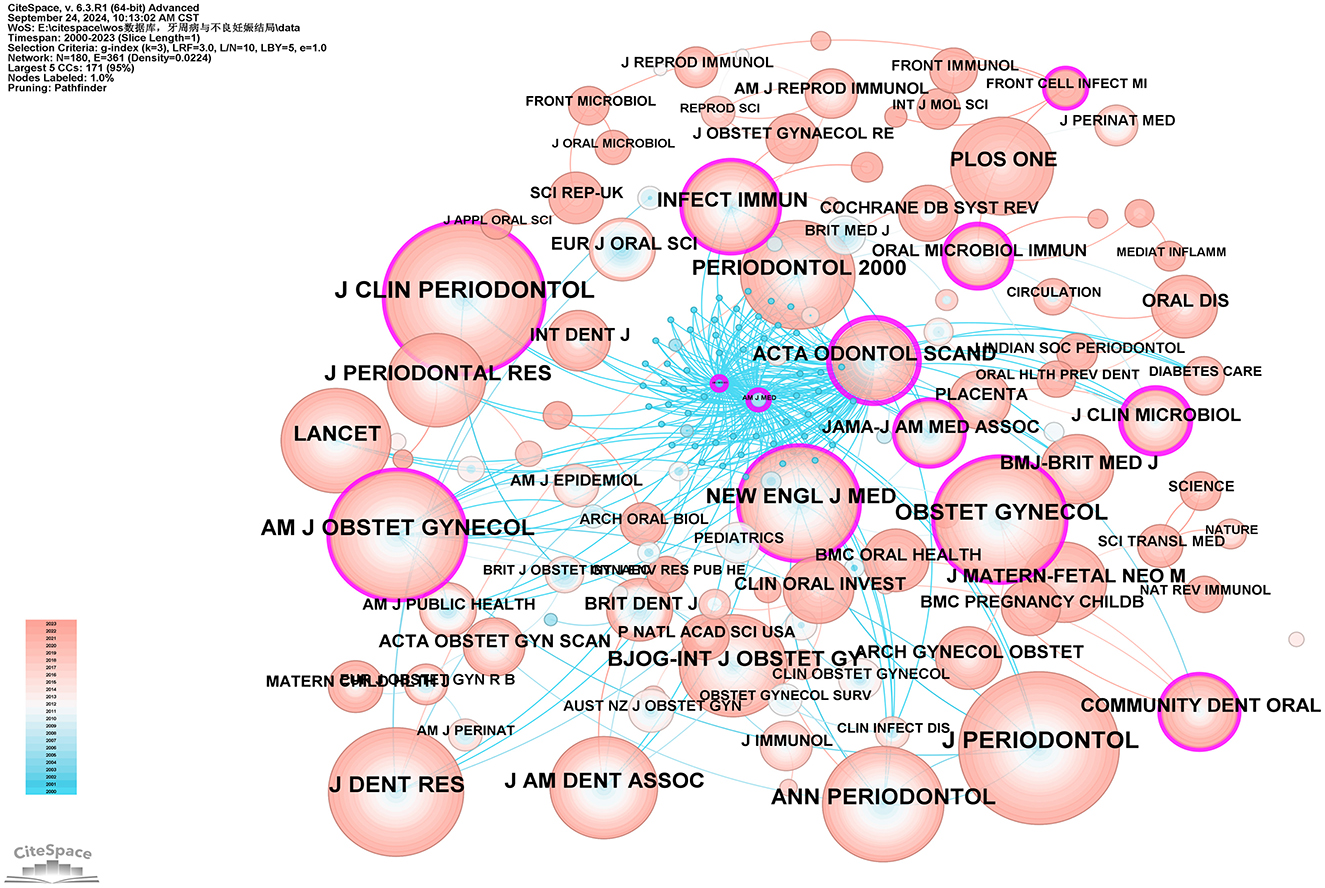
Figure 8. Co-cited network map of journals. After normalizing the sample literature (932 publications), the data were imported into CiteSpace for analysis. The selected time period spanned from 2000 to 2023, with the analysis focusing on “journals” to construct a co-citation network map of journals related to the relationship between PD and APOs. Node size represents the number of citations each journal received, while links between nodes indicate co-citation in the same paper. The different colors indicate the years in which citations occurred. The outermost purple ring signifies the degree of centrality, with nodes of high centrality regarded as key elements in the research field. The network parameters are as follows: g-index (k = 3), N = 180 (number of network nodes), E = 361 (number of connections), and Density = 0.0224 (network density).
3.4 Keyword analysis 3.4.1 Keyword co-occurrenceKeywords serve as concise summaries of articles and analyzing them helps identify research hotspots and emerging trends. This study identified a total of 191 keywords, with the top 10 most frequently occurring keywords being: “preterm birth” (n = 442), “low birth weight” (n = 371), “periodontal disease” (n = 350), “risk” (n = 274), “women” (n = 243), “disease” (n = 214), “infection” (n = 202), “association” (n = 195), “oral health” (n = 128), and “pregnancy” (n = 108; see Supplementary Table 9). Betweenness centrality (BC) values are used to measure a node's bridging role in the network, indicating its ability to connect other nodes. Keywords with high BC values typically represent potentially influential research directions or interdisciplinary research points. Using a threshold of BC = 0.2, the keywords are ranked from high to low as follows: “amniotic fluid” (0.45), “Porphyromonas gingivalis” (0.44), “risk factor” (0.39), “coronary heart disease” (0.36), “risk factors” (0.32), “labor” (0.31), “cardiovascular disease” (0.31), “inflammation” (0.30), “united states” (0.25), “lipopolysaccharide” (0.24), “weight” (0.22), “prematurity” (0.22), and “bacterial vaginosis” (0.20; see Supplementary Table 9; Figure 9).
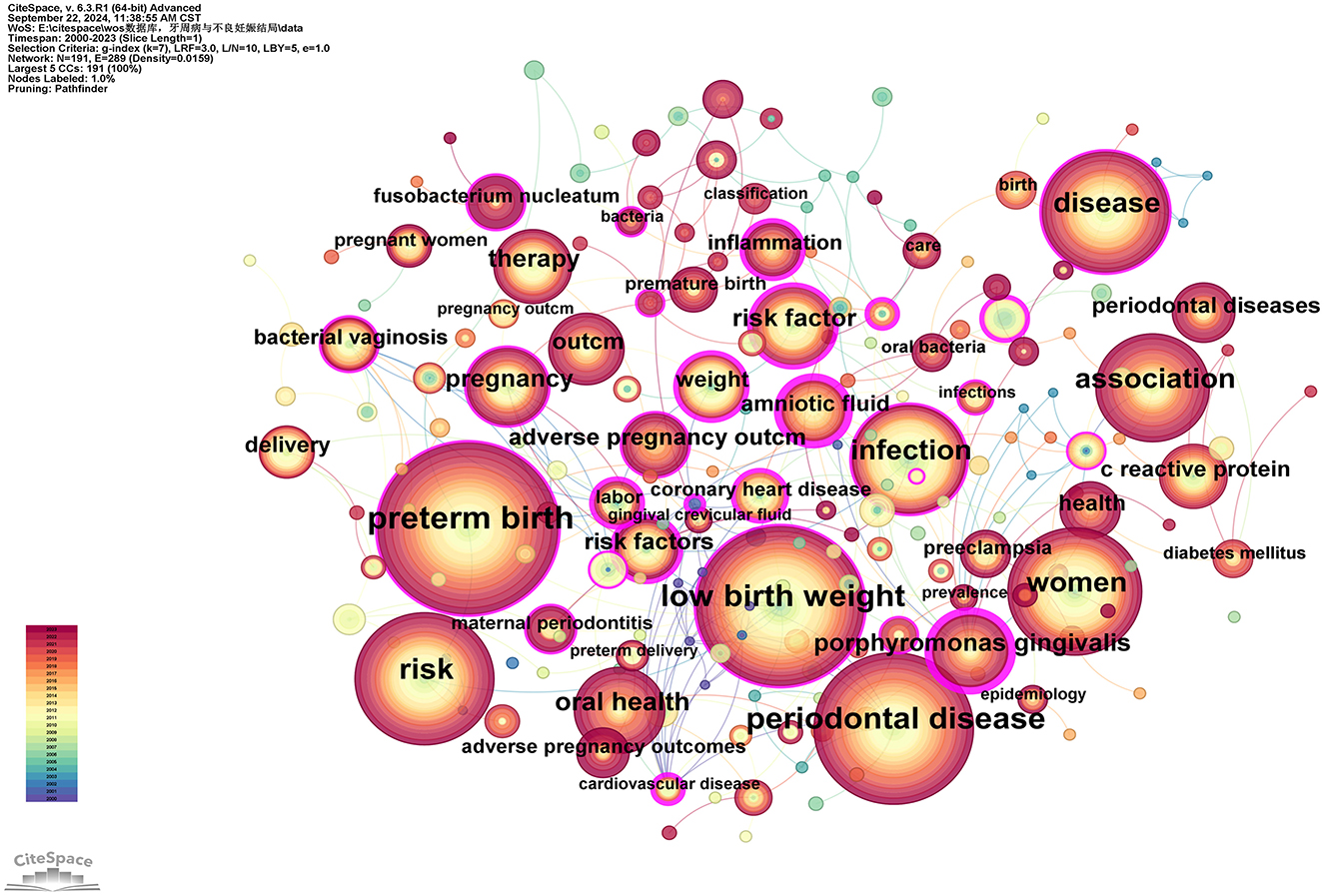
Figure 9. Keywords co-occurrence network map. After normalizing the sample literature (932 publications), the data was imported into CiteSpace for analysis. The selected time period spanned from 2000 to 2023, focusing on the “keywords” level to construct a co-occurrence network map of keywords related to the relationship between PD and APOs. Node size represents the frequency of keyword occurrences, while links between nodes indicate co-occurrence between different keywords. The years of occurrence are represented by different colors. The degree of centrality is shown by the outermost purple ring; nodes with high centrality are regarded as important locations in the research field. The network parameters are as follows: g-index (k = 7), N = 191 (number of network nodes), E = 289 (number of connections), and Density = 0.0159 (network density).
3.4.2 Keyword clusteringUsing the extracted keywords for cluster analysis, a total of 11 distinct clusters with different colors were generated, as shown in Figure 10. The average silhouette and modularity score of the clusters are 0.8936 and 0.7575, correspondingly, indicating effective network segmentation. The clusters exhibit clear structures, high quality, and are well-separated. Furthermore, the clusters are labeled in the following order: “Porphyromonas gingivalis (#0),” “adverse pregnancy outcomes (#1),” “amniotic fluid (#2),” “classification (#3),” “periodontal disease (#4),” “bacterial vaginosis (#5),” “oral health (#6),” “risk factors (#7),” “preterm birth (#8),” “perinatal mortality (#9),” and “Fusobacterium nucleatum (#10).” The clusters with the most keywords are “Porphyromonas gingivalis (#0)” and “adverse pregnancy outcomes (#1),” each containing 24 keywords (see Supplementary Table 10). The larger cluster sizes may indicate that these two areas have a broader research foundation compared to other clusters. The cluster with the highest silhouette score is “periodontal disease (#4),” which is commonly used to evaluate cluster cohesion and separation. A higher silhouette score suggests a high similarity of keywords within the cluster and a low similarity with other clusters. Below are some keywords and relevant descriptions for each cluster:
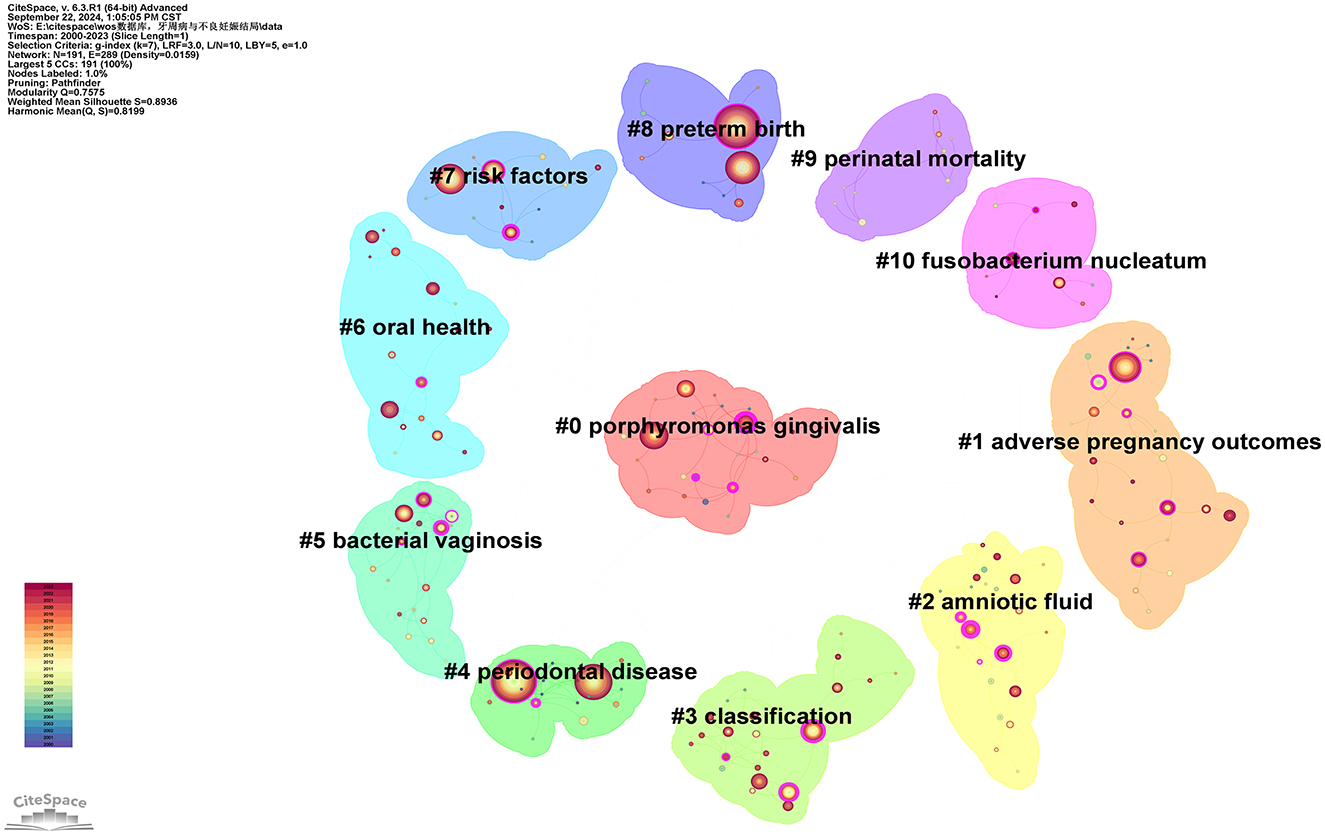
Figure 10. Keywords cluster network map.
Cluster #0 includes keywords such as “Porphyromonas gingivalis,” “coronary heart disease,” “C-reactive protein,” “bone mineral density,” and “atherosclerosis.” Porphyromonas gingivalis is a primary pathogen linked to PD, often causing chronic inflammation and destruction of periodontal tissues (50). This cluster is the largest in the Figure 10, indicating that a significant amount of research focuses on the pathogenic mechanisms of this bacterium in relation to PD.
Cluster #1 includes keywords such as “adverse pregnancy outcomes,” “pregnancy outcome,” “periodontitis,” and “maternal periodontitis.” This cluster directly addresses the relationship between PD and APOS, including PB, LBW, and FGR (7).
Cluster #2 includes keywords such as “amniotic fluid,” “oral bacteria,” “periodontal pathogens,” “oral health,” and “bone loss.” This cluster emphasizes the role of amniotic fluid infections or inflammation in pregnancy complications, particularly in relation to the potential connection with PD. Bacteremia caused by PD may lead to the invasion of bacteria or inflammatory mediators into the amniotic fluid, resulting in chorioamnionitis or other membrane infections, thereby increasing the risk of PB (51, 52). This cluster discusses how infections induced by periodontal disease can be detected through amniotic fluid analysis.
Cluster #3 includes keywords such as “classification,” “peri-implant diseases,” “risk factor,” “gestational diabetes mellitus,” and “periodontal medicine.” This cluster pertains to the classification studies of PD, which may include various subtypes of periodontitis and their differing impacts on systemic health (53). It likely addresses the pathogenesis of different types of PD and their correlation with pregnancy outcomes. Taxonomic studies can enhance the understanding of the etiology of PD and facilitate the development of personalized treatment plans targeting different types of periodontal conditions.
Cluster #4 includes keywords such as “periodontal disease,” “low birth weight,” “cardiovascular disease,” “periodontal diseases,” and “bacteria.” This cluster centers around PD, which represents a core topic within the research field. It addresses the pathophysiology of PD, the types of pathogenic bacteria involved, and how oral health management can prevent complications during pregnancy. Such studies assist in elucidating the direct relationship between PD and APOs.
Cluster #5 includes keywords such as “bacterial vaginosis,” “adverse pregnancy outcomes,” “delivery,” “randomized controlled trials,” and “prenatal care.” Bacterial vaginosis is a prevalent infection during pregnancy, often linked to PB and various other pregnancy-related complications (54, 55). This cluster explores the similarities or common mechanisms between bacterial vaginosis and PD, potentially focusing on how dysbiosis can lead to systemic inflammation, thereby affecting pregnancy outcomes.
Cluster #6 includes keywords such as “oral health,” “diabetes mellitus,” “periodontal diseases,” “periodontal disease,” and “dental care.” Oral health plays an important part as a significant factor influencing systemic health in this cluster. The relationship between periodontal health and pregnancy health is an important topic. This cluster investigates how oral hygiene management and periodontal treatment can improve pregnancy outcomes, particularly by reducing the risks of PB and LBW.
Cluster #7 includes keywords such as “risk factors,” “periodontal disease,” “adverse effects,” “periodontal diseases,” “complications,” “regression analysis,” and “possible association.” This cluster discusses various risk factors associated with PD and APOs.
Cluster #8 includes keywords such as “preterm birth,” “risk,” “Porphyromonas gingivalis,” “maternal oral health,” and “nursing.” PB is a core topic in the study of PD and pregnancy outcomes. This cluster discusses how periodontal infections may increase the risk of PB through systemic inflammatory responses or bacterial translocation (21). Such studies focus on how periodontal treatment interventions can reduce the rate of PB.
Cluster #9 includes keywords such as “perinatal mortality,” “randomized controlled trial,” “respiratory distress syndrome,” “calcium supplementation,” and “human chorionic gonadotropin.” This cluster investigates the potential link between perinatal mortality and PD. It discusses whether periodontal infections affect fetal survival rates, particularly in high-risk pregnancy populations, and whether PD significantly increases the risk of perinatal mortality as a complication (56).
Cluster #10 includes keywords such as “Fusobacterium nucleatum,” “oral microbiome,” “pregnant women,” “fusobacterium,” and “type I signal peptidase.” Fusobacterium nucleatum is another pathogen closely associated with PD. Additionally, this bacterium has garnered attention for its pathogenicity during pregnancy. This cluster explores how this bacterium may enter the placenta or fetus through bloodstream dissemination, potentially leading to APOs (57).
3.4.3 Keyword timelineAfter standardizing the sample literature (932 publications), the data was imported into CiteSpace for analysis of the chosen database, spanning from 2000 to 2023, with each time slice set to 1 year. The analysis item was set to “keywords,” resulting in a keyword co-occurrence map. By utilizing the timeline features, a timeline view of the role of PD in APOs from 2000 to 2023 was generated. As shown in Figure 11 and Supplementary Table 11, “periodontal disease” and “adverse pregnancy outcomes” have consistently been prominent keywords from 2000 to 2023, with a significant increase in research attention particularly between 2010 and 2023, highlighting the growing relevance and continuity of these topics. “Porphyromonas gingivalis (#0)” represents the largest cluster, and its prominence has notably increased since 2010, indicating its recognition as a key pathogen in the study of PD and APOs. Additionally, the timeline graph reveals connections between various keywords, such as the strong associations of “risk factor(s)” with “preterm birth,” “periodontitis,” “oral health,” and “cigarette smoking.” As time progresses, these intersections become more frequent, demonstrating an increasing convergence of research topics. Moreover, the crossing and connections of lines in the timeline illustrate the overlap of research fields in specific years. For example, “bacterial vaginosis” was a major topic of discussion from 2011 to 2015, during which “Fusobacterium nucleatum” also emerged and intersected with “oral microbiome,” a term that appeared after 2021. This reflects the growing body of research that bridges oral health with systemic health, offering more opportunities for interdisciplinary research in the future.
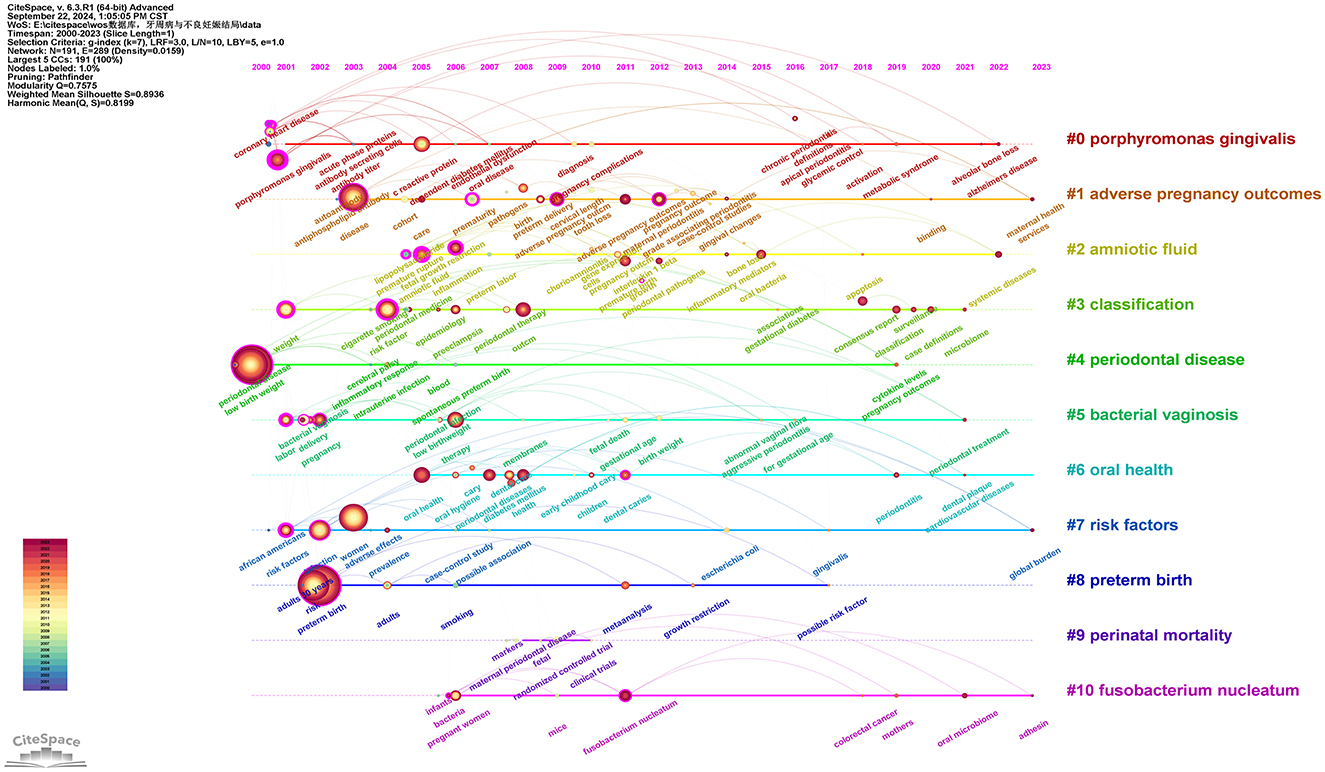
Figure 11. Keywords timeline network map. This figure illustrates the evolutionary trends of keywords related to PD and APOs from 2000 to 2023. In the figure, nodes represent keywords, with the size of each node indicating the frequency of the keyword, and the color representing the time of the keyword's first appearance. Links between nodes indicate co-occurrence relationships between the keywords.
3.4.4 Keyword time zoneUsing the above data, a keyword time zone analysis was conducted, illustrating the distribution and evolving trends of keywords across temporal and spatial dimensions. As shown in Figure 12, throughout the past 20 years, research on the relationship between PD and APOs has deepened and expanded continuously. The research focus has evolved from early foundational pathology and clinical observational studies to more complex areas such as oral microbiome, vaginal microbiome, inflammatory factors, gene expression, and preventive and therapeutic aspects of oral health. These studies provide valuable insights into how PD affects APOs and highlight future research directions (see Supplementary Table 11).
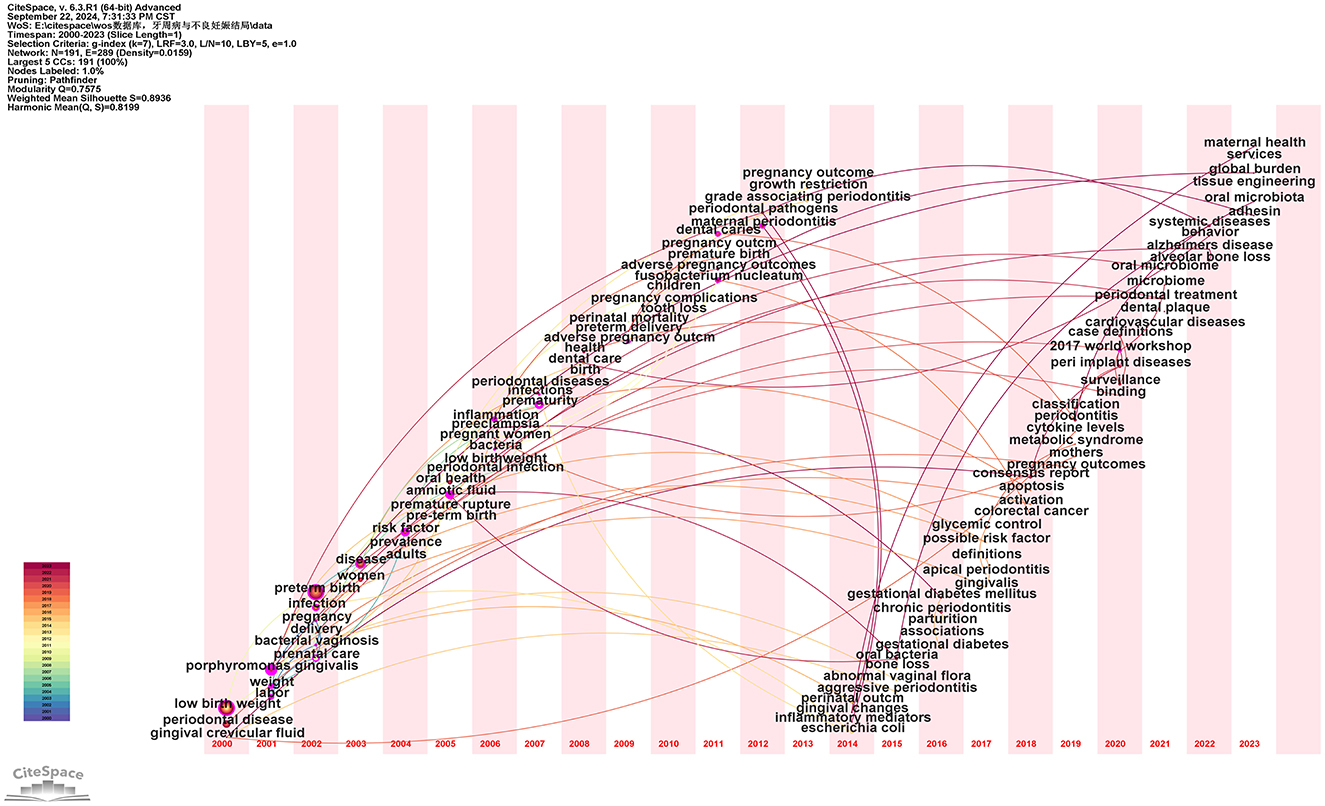
Figure 12. Keyword time zone map. In this figure, nodes represent keywords, with the size of each node indicating the frequency of the keyword, and the color representing the time of the keyword's first appearance. Links between nodes indicate co-occurrence relationships between the keywords.
3.4.5 Hotspots and cutting-edge topicsThe emergence of sudden keywords is related to the repeated appearance of specific terms by scholars in a defined timeframe (42). As shown in Figure 13, the analysis conducted using CiteSpace reveals the top 20 keywords with the strongest citation bursts. Overall, the burst durations of these 20 keywords spanning from 1 to 8 years, with burst intensity varies between 4.31 and 11.93. The keyword with the strongest burst (intensity = 11.93) is “infection,” with the burst citation occurring between 2002 and 2009. The second strongest burst (intensity = 7.65) is “risk factors,” occurring from 2001 to 2005. Both keywords have garnered significant attention since their initial appearance, quickly becoming frequently cited terms. This reflects the academic community's heightened focus on PD as a major source of infection and risk during pregnancy, further prompting in-depth discussions on the inflammatory mechanisms and risk management concerning pregnancy outcomes. Additionally, the keyword “oral bacteria” has the longest burst duration. The earliest emergent keyword in this study is “risk factors,” while “adverse pregnancy outcomes” and “consensus report” are the latest additions since 2020. A comprehensive analysis of these along with currently frequently cited keywords such as “oral bacteria,” “health,” “oral health,” and “classification” indicates that they may represent the current hot topics and future trends in the research on PD and APOs.
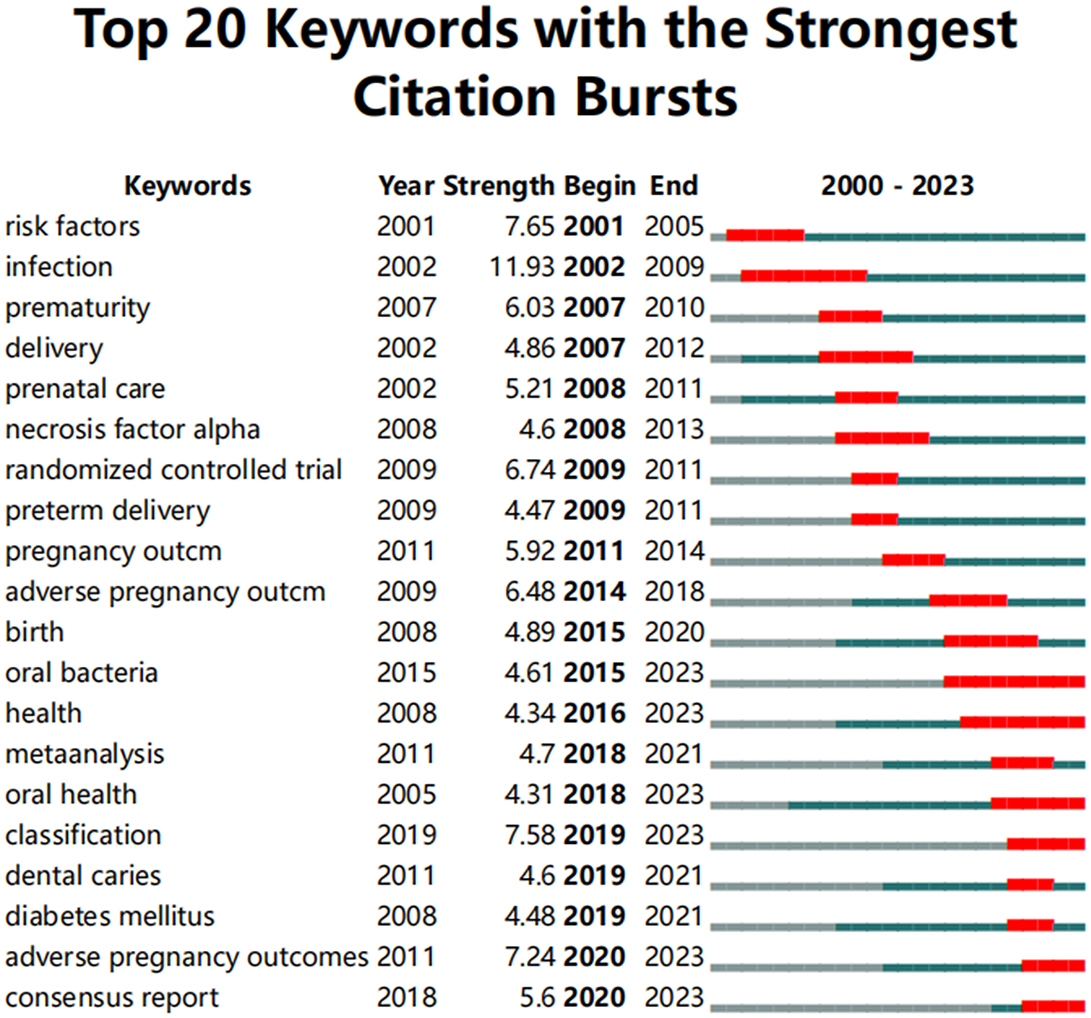
Figure 13. Top 20 keywords with the strongest citation bursts. The red line represents years when keywords burst, and the blue line indicates years when keywords were used less frequently. Burst strength reflects the occurrence times of keywords in a certain period. Each keyword burst lasts for a minimum duration of 3 years.
3.5 Systematic search analysisAs a complement to the bibliometric analysis, we conducted a systematic screening of the 932 articles identified in the WoSCC database. The screening process was based on their titles, abstracts, keywords, and full texts, followed by six points of systematic analysis: (a) Statistical analysis of studies on gingivitis/periodontitis/PD and APOs: As shown in Figure 14A, 16 studies were identified as related to gingivitis and APOs, 157 studies to periodontitis and APOs, and 356 studies to PD, including both gingivitis and periodontitis, related to APOs. A detailed list of these articles is provided in Sheet 1 in Supplementary Table 14. (b) Analysis of articles by study design: According to Figure 14B, research designs investigating the relationship between PD and APOs include Case-control studies (109), Cross-sectional studies (76), Systematic reviews (61), Prospective cohort studies (55), Animal studies (37), RCT (intervention study) (37), Comparative studies (28), Prevalence studies (17), Case reports (5), and Retrospective cohort studies (3). Case-control studies were the most common. Additionally, the top three most-cited articles in the first six study designs were tabulated, as shown in Table 1. Detailed lists and content analyses (e.g., animal models/population characteristics, outcome indicators, main conclusions) for these study types are included in Supplementary Table 15. (c) Statistical analysis of key oral bacteria in APOs: As shown in Figure 14C, oral bacteria investigated in more than 10 studies include Porphyromonas gingivalis (72 studies), Fusobacterium nucleatum (50 studies), Tannerella forsythia, Aggregatibacter actinomycetemcomitans, Prevotella intermedia, Campylobacter rectus, and Treponema denticola. Most studies focused on chronic periodontitis-associated bacteria, particularly those from the red and orange microbial complexes in subgingival plaque. Detailed lists of these bacteria-related studies are provided in Sheet 2 in Supplementary Table 14. (d) Statistical analysis of risk factor studies: As shown in Figure 14D, risk factors were categorized into four groups: independent risk factors for APOs (114), independent risk factors for PD (37), shared risk factors for PD and APOs (129), and factors associated with the PD-APOs relationship (450). Research on risk factors aids in early identification, prevention, and treatment efforts. Further details are provided in Sheet 3 in Supplementary Table 14. (e) Statistical analysis of studies on the role of non-surgical periodontal therapy in APO prevention: According to Figure 14E, interventions were roughly classified into non-surgical periodontal therapy, oral health promotion, drug therapy, mental and psychological regulation, screening and prediction of APOs, and diet/nutrition. Research specifically on the prevention of APOs through non-surgical periodontal therapy included 72 studies. Detailed information is available in Sheet 4 in Supplementary Table 14. (f) Statistical analysis of APO types and their relationship with PD: As shown in
Comments (0)